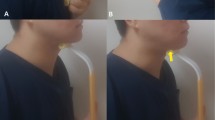Abstract
Earlier studies of the effect of 6 weeks of the Shaker Exercise have shown significant increase in UES opening and anterior excursion of larynx and hyoid during swallowing in patients with upper esophageal sphincter (UES) dysfunction, resulting in elimination of aspiration and resumption of oral intake. This effect is attributed to strengthening of the suprahyoid muscles, as evidenced by comparison of electromyographic changes in muscle fatigue before and after completion of the exercise regime. The effect of this exercise on thyrohyoid muscle shortening is unknown. Therefore the aim of this study was to determine the effect of the exercise on thyrohyoid muscle shortening. We studied 11 dysphagic patients with UES dysfunction. Six were randomized to traditional swallowing therapy and five to the Shaker Exercise. Videofluoroscopy was used to measure deglutitive thyrohyoid shortening before and after completion of assigned therapy regimen. Maximum thyrohyoid muscle shortening occurred at close temporal proximity to the time of maximal thyroid cartilage excursion. The percent change in thyrohyoid distance from initiation of deglutition to maximal anterior/superior hyoid excursion showed no statistically significant difference between the two groups prior to either therapy (p = 0.54). In contrast, after completion of therapy, the percent change in thyrohyoid distance in the Shaker Exercise group was significantly greater compared to the traditional therapy (p = 0.034). The Shaker Exercise augments the thyrohyoid muscle shortening in addition to strengthening the suprahyoid muscles. The combination of increased thyrohyoid shortening and suprahyoid strengthening contributes to the Shaker Exercise outcome of deglutitive UES opening augmentation.




Similar content being viewed by others
References
Shaker R, Kern M, Bardan E, Taylor A, Stewart ET, Hoffmann RG, et al. Augmentation of deglutitive upper esophageal sphincter opening in the elderly by exercise. Am J Physiol. 1997;272(35):G1518–22.
Shaker R, Easterling C, Kern M, Nitschke T, Massey B, Daniels S, et al. Rehabilitation of swallowing by exercise in tube-fed patients with pharyngeal dysphagia secondary to abnormal UES opening. Gastroenterology. 2002;122:1314–21.
Cook IJ, Dodds WJ, Dantas RO, Massey BT, Kern MK, Lang IM, et al. Opening mechanisms of the human upper esophageal sphincter. Am J Physiol. 1989;257:G748–59.
Logeman J, Pauloski B, Rademaker A, Colangelo L. Super-supraglottic swallow in irradiated head and neck cancer patients. Head Neck. 1997;19:535–40.
Bulow M, Olsson R, Ekberg O. Videomanometric analysis of supraglottic swallow, effortful swallow, and chin tuck in patients with pharyngeal dysfunction. Dysphagia. 2001;16:190–5.
Williams RB, Wallace KL, Ali GN, Cook IJ. Biomechanics of failed deglutitive upper esophageal sphincter relaxation in neurogenic dysphagia. Am J Physiol Gastrointest Liver Physiol. 2002;283(1):G16–26.
Shaker R, Dodds WJ, Dantas RO, Hogan WJ, Arndorfer RC. Coordination of deglutitive glottic closure with oropharyngeal swallowing. Gastroenterology. 1990;98(6):1478–84.
Cook IJ, Dodds WJ, Dantas RO, Kern MK, Massey BT, Shaker R, et al. Timing of videofluoroscopic, manometric events and bolus transit during the oral and pharyngeal phases of swallowing. Dysphagia. 1989;4:8–15.
Medda BK, Kern M, Ren J, Xie P, Ulualp SO, Lang IM, et al. Relative contribution of various airway protective mechanisms to prevention of aspiration during swallowing. Am J Physiol Gastrointest Liver Physiol. 2003;284(6):G933–9.
Kahrilas PJ, Lin S, Chen J, Logemann JA. Oropharyngeal accommodation to swallow volume. Gastroenterology. 1996;111(2):297–306.
Kahrilas PJ, Logemann JA, Krugler C, Flanagan E. Volitional augmentation of upper esophageal sphincter opening during swallowing. Am J Physiol. 1991;260:G450–6.
Acknowledgments
The authors thank the following people for their contributions to this study: Carrie Stangl McBreen (Voice, Speech and Language Service and Swallowing Center, Northwestern University, Chicago, IL), Amy Kelly (Evanston Northwestern Healthcare, Evanston, IL), Barbara Grande (St. Joseph Regional Medical Center, Milwaukee, WI), Jodi Antinoja (Froedtert Hospital, Neurology Rehab Department, Milwaukee, WI), Julie Farquharson (Walter Reed Army Medical Center, Washington, DC), Lisa Newman and Joy Graziano (H. Lee Moffitt Cancer Center, Tampa, FL), and John Sandidge (St. Joseph’s of Atlanta, Atlanta, GA).
Author information
Authors and Affiliations
Corresponding author
Rights and permissions
About this article
Cite this article
Mepani, R., Antonik, S., Massey, B. et al. Augmentation of Deglutitive Thyrohyoid Muscle Shortening by the Shaker Exercise. Dysphagia 24, 26–31 (2009). https://doi.org/10.1007/s00455-008-9167-y
Received:
Accepted:
Published:
Issue Date:
DOI: https://doi.org/10.1007/s00455-008-9167-y




